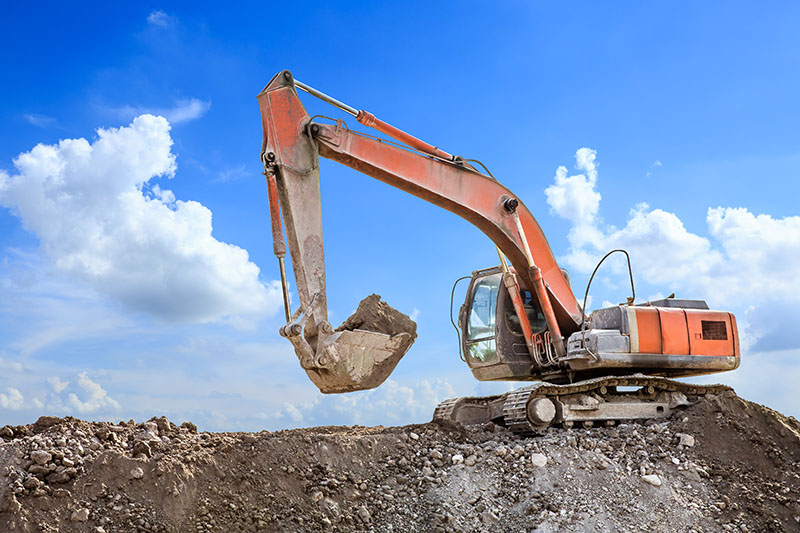Your mini excavator may be little, but it’s built for tough work. The final drive motor is a big reason why. Located in the undercarriage, this important piece of machinery draws power from the engine and sends it to the tracks. That’s how your machine digs, pushes, and moves with strength and accuracy.
In small equipment, room is tight. That means each component has to be able to do more in less room. Mini final drives are engineered to meet the challenge. They deliver rugged performance, cost-saving efficiency, and reliable durability. Above all, they work to minimize downtime and get your projects back on track.
Here, we’ll explain what each part of the final drive system does. You’ll learn how to keep it in tip-top operating condition, when to replace it, and how to find a high-quality aftermarket drive. We’ll disclose too what makes a final drive worth your dollars—and your time.

What is a Final Drive?
A final drive is one of the most important parts of heavy machinery, especially for mini excavators. It’s the last part of the powertrain. Its job is to turn hydraulic energy into the mechanical power that moves the tracks or wheels. Without it, your machine wouldn’t move at all.
The final drive also helps transfer torque efficiently. This is key for smooth movement and carrying heavy loads. In mini excavators, a reliable final drive helps reduce downtime and keeps the machine working at full capacity.
Each excavator’s final drive is made up of several critical components:
- The hydraulic motor: It is the part that gets the hydraulic pressure from the main pump and generates motion.
- The gear set: The set is celebrated for durability and efficiency, as it amplifies the motor torque created to allow your mini excavator to cross even rough terrain.
- The gear oil: The lubricant that keeps all in shipshape condition, with the inevitable passage of time, reducing wear and friction.

Understanding Mini Excavator Final Drives
All final drives do the same basic job—they transfer engine power to the tracks. But the final drives in mini excavators are built differently than those in full-sized machines.
Mini excavators are used on confined spaces and sensitive jobs, so the replacement parts of these machines must be light, small, but heavy-duty. Mini final drives are thus designed to possess the same dimension, weight, and hydraulic capacity as these tiny machines. They might be smaller, yes, but they give the torque and nimbleness required by rough construction sites.
Another great benefit of brand new mini final drives is that they are cost-effective. The small systems not only save money and time to maintain, but also consume less power, thus decreasing operating costs. Additionally, their compact size allows them to be easily installed and repaired, saving time.
Most mini excavator end drives have miniature travel motors, sealed planetary gear sets, and optimized cases. For compatible components, the travel deceleration mechanism is a proper choice for mini and heavy equipment with effective power transfer in a small area.
What Are Final Drive Motors?
The final drive motor is the major moving part of your mini excavator. It’s a hydraulic motor that powers the final drive. It takes hydraulic power and translates it into mechanical force to move the tracks. This enables your machine to push over job site obstacles.
For a mini excavator, it is all about strength and size. The engine must be strong but small. It must have the right amount of torque and efficiency to work in small spaces.
Choosing the right final drive motor isn’t just about finding one that fits. It’s about performance, machine life, and long-term savings. A poor-quality or wrong motor can waste fuel, slow your work, or damage the final drive. That’s why it’s important to buy high-quality motors that match your machine’s brand.
There are a few types of travel motors. They’re typically separated by speed (one or two) and shape (with or without planetary internal gears). The right one will be based on your size, model, and type of work.
Whether you’re replacing a broken motor or wanting to upgrade for better performance, knowing how final drive motors work is a good idea. It enables you to buy smarter, avoid downtime, and get your equipment to run longer and harder.
Signs Your Mini Excavator Final Drive Needs Replacement
Your mini excavator works hard—but when its final drive starts to fail, your whole job comes to a standstill. Capturing the warning signs ahead of time can save you from waiting for small issues to become costly repairs.
Some of the most common warning signs of a failing final drive motor include:
- Grinding and clicking noises while the machine is moving
- Power loss or sluggish traveling speed
- Excessive overheating, especially after short usage
- Leaks or low final drive gear oil
- Abnormal or jerky movement
These signs are likely to point towards internal wear in the motor, gear, or contamination within the final drive. Worn O-rings or damaged seals can allow fluid leakage, impacting performance and overheating in certain cases.

How to Choose the Right Excavator Final Drive
Step one is to ensure compatibility with your machine. There are unique size, speed, and torque demands for each excavator. Operating with an incompatible motor can decrease efficiency or even destroy the drive system. Check your equipment’s specs or refer to your manual to determine the proper final drive motor model.
Think about Performance and Operating Conditions
Think about where and under what conditions your gear is working. Steep grades or rough terrain? You’ll need a final drive with high torque and durability. Wet or dirty environments? Choose units with strong sealing and quality assurance to protect against contamination and less downtime. For demanding jobs, a rotary deceleration mechanism may be ideal—designed for strength and smooth motion control in challenging conditions.
OEM vs. Aftermarket Final Drives
OEM final drives are made by your excavator’s manufacturer and offer guaranteed fit and operation—but sometimes at a higher price. Final drives are also available in the aftermarket and can be a great value and equal quality when bought from reputable firms with visible industry experience and great warranty, like a two year warranty.
Ensure Fitment and Compatibility
Double-check the mounting sizes, gear specifications, and hydraulic fittings before you make the purchase. Small variations can lead to installation problems. If you’re not sure, consult the supplier—they can direct you to the correct inventory for your mini excavator, particularly when you’re working with big names or specialty models.
Maintaining Your Final Drive and Final Drive Motor
Mini excavators plod along in close quarters and dense soil, so their final drives must be serviced regularly to operate at their best. A little TLC can mean a lot—particularly when you’re counting on solid performance.
- Keep oil health in check. Gear oil is the life of your last drive. Check the level and quality every 100 hours. If it’s milky (water in the oil) or gritty (metal filings), it needs a change. Use only premium oil, and don’t forget to clean out the magnetic drain plug—it traps grit before it hurts anything.
- Inspect for everyday wear. Inspect for outside damage such as broken seals, dented lids, or oil along the sprocket region. These are not aesthetic—more often than not, they indicate internal pressure issues or worn-out bearings.
- Keep your motor away from dusty or dirty work sites. Final drive motors dislike clogged case drains and overheating housing. Clean the area around the drive. A perpetually overheating or case drain-leaking motor may require more than maintenance—it needs to be replaced.
If you’re working in specialized conditions—like high-altitude lifts or obstacle removal—you’ll benefit from more robust drive systems like rotating mechanisms for high-altitude vehicles. These are designed to handle extra stress and extend equipment life.
Frequently Asked Questions (FAQ)
- What is the difference between a mini final drive and a full-sized final drive?
The general purpose remains the same—both transmit engine torque to the tracks. The main difference is size and torque. Mini final drives are made for smaller equipment and give less torque but are able to maneuver around in small spaces.
- How long does a mini final drive last?
With good upkeep, a mini final drive will last 3,000 to 5,000 hours. Abusive use, skipped fluid changes, or dirty working conditions cut that lifespan.
- Can I repair my mini excavator final drive motor myself?
Some basic fix-ups—such as seal replacement or oil checks—can be performed by you if you are mechanically capable. But for interior work or complete overhauls, let a professional handle it so that the motor is not ruined or warranties are not voided.
- What is the cost of replacing a final drive motor for a mini excavator?
They can have competitive prices ranging from $1,500 to $4,000, depending on model and what major brands offer. Aftermarket ones are generally cheaper, but be sure to verify compatibility and warranty.
Final Thoughts
Your final drive and motor are critical to how well your mini excavator performs. Replacing it with the right unit isn’t only about getting your machine up and running again—it’s about maintaining efficiency, avoiding breakage in the future, and keeping your investment intact in the future. Whether you’re noticing power loss, hearing strange noises, or just looking forward to the future, knowing your final drive system is one step ahead on the job in providing excellent service.
If you’re unsure which final drive or motor fits your machine best, don’t guess—get expert help from an industry leader like us. Explore available final drive options at Zhihe Transmission or reach out to discuss your machine model and project needs. A better match means better results.




